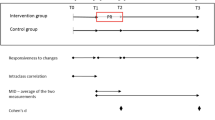Abstract
Background: Asthma treatment has broadened from managing clinical markers to incorporate factors that are most meaningful to patients, collectively called health-related quality of life (HQL). Objective: To develop an asthma-specific HQL tool, meeting demands for brevity, usefulness and measurement precision. Methods: The 20-item Sydney Asthma Quality of Life Questionnaire (AQLQ) and six additional items were studied using factor analysis, reliability and validity tests among asthma patients 14 and older. Results: The 15-item Integrated Therapeutics Group Asthma Short Form (ITG-ASF) retains the validity of the AQLQ with improved scaling properties and interpretability. The ITG-ASF yields 6 scores: Symptom-Free Index, Functioning with Asthma, Psychosocial Impact of Asthma, Asthma Energy and Asthma-Confidence in Health and a Total. All items correlated 0.40 or higher with their hypothesized scales and passed discriminant validity tests, with scaling success rates from 75 to 100%. Reliability exceeded the minimum of 0.70 for group comparisons. Ceiling and floor effects were acceptable. Scales were valid in relation to changes in asthma severity and lung function. The best predictor of asthma severity (National Asthma Education and Prevention Program (NAEPP) staging) was the Symptom-Free Index. A Spanish translation is available, Chinese-American is forthcoming. The reading grade level is 4.8. Conclusions: Development of the ITG-ASF was a data-driven process maximizing measurement precision and breadth while minimizing burden. The ITG-ASF is a brief, comprehensive and empirically valid tool that complements traditional markers of the outcomes of asthma care.
Similar content being viewed by others
References
F-D-C Reports Pharmaceutical Approvals Monthly, November 1996; 3–6.
Weiss KB, Gergen RJ, Wagenes OK. Breathing better or wheezing worse? The changing epidemiology of asthma morbidity and mortality. Annu Rev Publ Health 1993; 14: 491–513.
Rose R, Weiss KB. An overview of outcomes measurement in asthma care. Immunol Allergy Clin North Am 1996; 16: 841–858.
Bukstein DA. Practical approach to the use of outcomes in asthma. Immunol Allergy Clin North Am 1996; 16: 859–891.
Epstein RS, Sherwood LM. From outcomes research to disease management: A guide for the perplexed. Ann Intern Med 1996; 124: 832–837.
Steinwachs DM, Wu AW, Skinner EA. How will outcomes management work? Health Aff (Millwood) 1994; 13: 153–162.
Guyatt GH, Feeny DH, Patrick DL. Measuring health-related quality of life. Ann Int Med 1993; 118(8): 622–629.
Juniper EF, Guyatt GH. Asthma and Allergy. Chapter 101. Quality of Life and Pharmacoeconomics in Clinical Trials, 2nd edn., B. Spilker (ed.), Philadelphia: Lippincott-Raven Publishers, 1996.
Juniper EF, Guyatt GH, Ferrie PJ, Griffith LE. Measuring quality of life in asthma. Am Rev Respir Dis 1993; 147: 832–838.
Marks GB, Dunn SM, Woolcock AJ. A scale for the measurement of quality of life in adults with asthma. J Clin Epidemiol 1992; 45(5): 461–472.
Marks GB, Dunn SM, Woolcock AJ. An evaluation of an asthma quality of life questionnaire as a measure of change in adults with asthma. J Clin Epidemiol 1993; 46(10): 1103–1111.
Hyland ME, Finnis S, Irvine SH. A scale for assessing quality of life in adult asthma sufferers. J Psychosom Res 1991; 35(1): 99–110.
Jones PW, Baveystock CM, Littlejohns P. Relationships between general health measured with the Sickness Impact Profile and respiratory symptoms, physiologic measures, and mood in patients with chronic airflow limitation. Am Rev Respir Dis 1989; 140: 1538–1543.
Juniper EF, Buist AS, Cox FM, Ferrie PJ, King DR. Validation of a standardized version of the Asthma Quality of Life Questionnaire. Chest 1999; 115(5): 1265–1270.
Quirk FH, Jones PW. Patients' perception of distress due to symptoms and effects of asthma on daily living and an in-vestigation of possible influential factors. Clin Sci 1990; 79(1): 17–21.
Jones PW, Quirk FH, Baveystock CM, Littlejohns P. A self-complete measure of health status for chronic airflow limitation. The St. George's Respiratory Questionnaire. Am Rev Respir Dis 1992; 145(6): 1321–1327.
Hyland ME. The Living with Asthma Questionnaire. Respir Med 1991; 85(Suppl B): 13–16.
Ware JE, Kemp JP, Buchner DA, Singer AE, Nolop KB, Goss TF. The responsiveness of disease-specific and generic health measures to changes in the severity of asthma among adults. Quality of Life Res 1998; 7: 235–244.
Bayliss MS, Espindle DM, Ware JE Jr. Asthma Outcomes Monitoring System: Baseline Psychometric Report. Quali-tyMetric, Inc., Lincoln, RI, 1998.
Bayliss MS, Espindle DM, Ware JE Jr. Asthma Outcomes Monitoring System Final Report: Development, Validation and Analysis of Pilot Study. QualityMetric, Inc., Lincoln, RI, 1998.
Likert R. A technique for the measurement of attitudes. Arch Psychol 1932; 140: 5–55.
Nunnally JC. Psychometric Theory. New York: McGrawHill, 1978.
Liang MH, Larson MG, Cullen KE, et al. Comparative measurement efficiency and sensitivity of five health status instruments for arthritis research. Arthritis and Rheumatism 1985; 28: 542–547.
Ware JE, Kosinski M, Bayliss MS, McHorney CA, Rogers WH, Raczek A. Comparison of methods for the scoring and statistical analysis of the SF-36 health pro®les and summary measures: summary of results from the Medical Outcomes Study. Medical Care 1995; 33(Suppl 4): AS264–AS279.
McHorney CA, Ware JE, Lu JFR, Sherbourne CD. The MOS 36-item short-form health survey (SF-36): III. Tests of data quality, scaling assumptions and reliability across diverse patient groups. Med Care 1994; 32: 40–66.
Helmstadter GC. Principals of Psychometric Measurement. New York: Appleton-Century-Crofts, Inc., 1964.
Howard KI, Forehand GG. A method for correcting item-total correlations for the e€ect of relevant item inclusion. Edu Psychol Measur 1962; 22: 731–735.
Ware JE, Harris WJ, Gandek B, Rogers BW, Reese PR. MAP-R for Windows: Multitrait/Multi-Item Analysis program-Revised User's Guide. Boston, MA: Health Assessment Lab, 1997.
Cronbach LJ, Warrington WG. Time-limit tests: Estimat-ing their reliability and degree of speeding. Psychometrika 1951; 16: 167–188.
Keller SD, Bayliss MS, Ware JE Jr, Hsu MA, Damiano AM, Goss TF. Comparison of responses to SF-36 Health Survey questions with one-week and four-week recall periods. Health Serv Res 1997; 32(3): 367–384.
Author information
Authors and Affiliations
Rights and permissions
About this article
Cite this article
Bayliss, M.S., Espindle, D.M., Buchner, D. et al. A new tool for monitoring asthma outcomes: The ITG Asthma Short Form. Qual Life Res 9, 451–466 (2000). https://doi.org/10.1023/A:1008939328060
Issue Date:
DOI: https://doi.org/10.1023/A:1008939328060




